The morning began with my son sending me this (note #29) and after that I still had the pleasure of writing about Charles Correa to look forward to…
As promised yesterday, here are some glimpses of what may well be Charles’s greatest achievement (so far – there are many yet to come). It is the Champalimaud Center for the Unknown, in Lisbon, Portugal.
The site is spectacular,  as will be evident from these pictures.
as will be evident from these pictures.
.
And the building rises magnificently to the challenge.
Charles has succeeded in creating a startlingly new configuration of some of the recurring elements in his work: sculptural monoliths;
echoing geometrical forms;
reflecting surfaces;
courtyards that both embrace and separate;
and the interplay of light and shadow.
The landscaping is particularly striking in its references to Portugal’s role in the diffusion and exchange of botanical species around the world.
At the age of eighty-one Charles has the spirit, energy, liveliness of mind and argumentativeness of a teenager (and the sense of mischief too). In the league of his peers he is indeed a stripling: Niemeyer at 104 and I.M.Pei at 97 are still producing some of their best work. There are many projects ahead for Charles and we can only hope that those who have it in their power to commission major buildings will make it possible for him to build something on the scale of the Champalimaud Center in India.
[For the record: I didn’t take these pictures; they were sent to me a good while ago. No photographerwas credited].

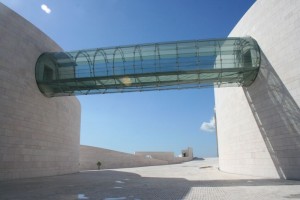
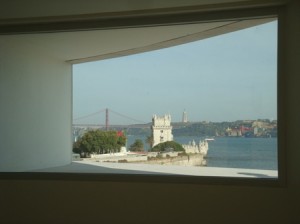

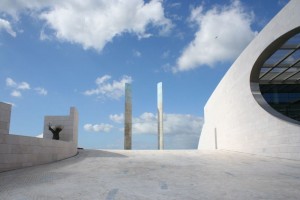
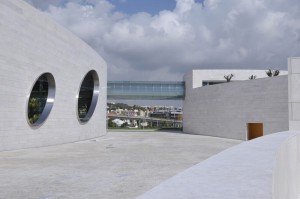
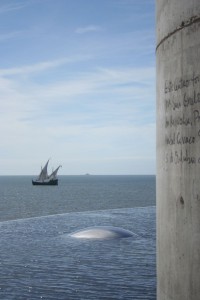

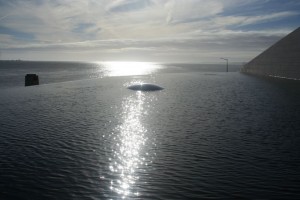
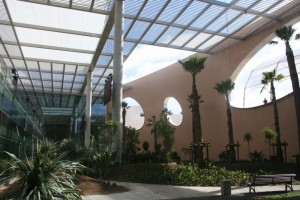
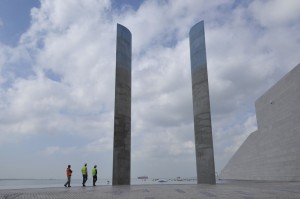
Glad to see ‘Sea of Poppies’ on the Harvard list.
I am also flattered at the attention you paid to the comment and how you took it forward.
Gehry is no doubt a pioneer (sadly, I have not seen any of his buildings).
But Correa is a living presence in Delhi where I live and his red LIC building looms over Connaught Place, as does the British Council.
I made me think of the architect a different sort of artist. What he or she makes cannot be avoided or brushed aside unlike a musical composition, film, painting, dance or book.
Like we cannot brush aside the structure (we cannot even avoid taking the road) or not see it, and if it is a public utility (hospital or university) or a commercial structure, we cannot even avoid using it. One hates it, but one has to use it. But if one likes it, the beauty, the utility gives the person happiness.
So whatever an architect creates goes into public domain instantly, it in fact begins to define public domain (like in the case of the Stein’s India Habitat Centre or Connaught Place). So nothing the architect does can ever be personal, I feel, except for his own house, perhaps, which too is imitated, which brings us back to the questionable picture of the architect in Zizek’s favourite film ‘The Fountainhead’.
So the architect is a public figure– whether he likes it or not. If people feel angry at what he has created since they are now forced to see it everyday and even use it, the architect is held responsible. Sadly in India, the architect is not a public figure. Few in my office know Correa.
Few know or care that the symbols of India’s dizzying growth– the entire glass and steel edifice of the DLF, or Infosys (a representative of the IT buildings), or luxury apartments– have been drawn out in Hafeez Contractor’s office. I had met him once, and he said when people marvel at his differently-shaped steel and glass IT buildings and he laughed. “It so easy to make—this way, that way (moving his hands) and its done,” he said. “Speed is success,” he said. I think what he meant was glass and steel are money. That is why eight of the ten new buildings I see today are like that, all round my office in Noida, and Gurgaon.
But some years ago, I also met a different kind of architect– a youth who happened to be a Bengali. Somnath Ray, from a middle-class background, was schooled in Chandigarh, but somehow made it Columbia University, and from there he went to MIT, studying design. I had met him because he had won a big international contest– creating “smart” cities.
In 2007, he had created ParaCity, a beehive-like colony, over what looked like Manhattan. He said he had multiplied the Penrose tiles to make “habitat cells”.
I lost track of him afterward, but yesterday, after reading your post, I searched for him on the net, and found that he was running a structural designing company in Delhi (much like Cecil Balmond of Arup) and creating or proposing to create shocking and surprising structures to make, as he said, infrastructure “smarter” with strange “interventions”.
http://www.dplay.org/
I think he represents the next generation of architects which are more mathematical and computational than the artistic, using the computer brain to push the laws of geometry. The future of urban space, I think, will an image of their concepts. Who else would think of putting up a green belt with trees, grass and parks over the a 124-km long Delhi Metro tracks so that one can also cycle or walk to office over a running train!
http://indian-architects.com/en/projects/detail_thickbox/30851/plang:en-gb?iframe=true&width=850&height=99
I have my reservations about the LIC building (which I too lived with for a long time) – the British Council building I have yet to see. But this is a conversation that should be continued – and thanks for the links.
Charles I think a living legend as far as India is concerned.An architect who redesign style of thinking of the society.The innovative ideas & thirst for looking something new can be understood because I am also an architect & professor.
Charles correas champalimaud center is a master piece which touches you even though one has not visited the place . His work is has pushed the boundry of architecture and has successfuly demonstrated the freedom this great mind practices . His spaces are design of expierences the medium of material so apt that it is blending with site and utility at the same time . I think this freedom is what architecture is about . A bold and sensous touch with a humane touch .
Hope to see more in the best to come projects by the genius in correa .